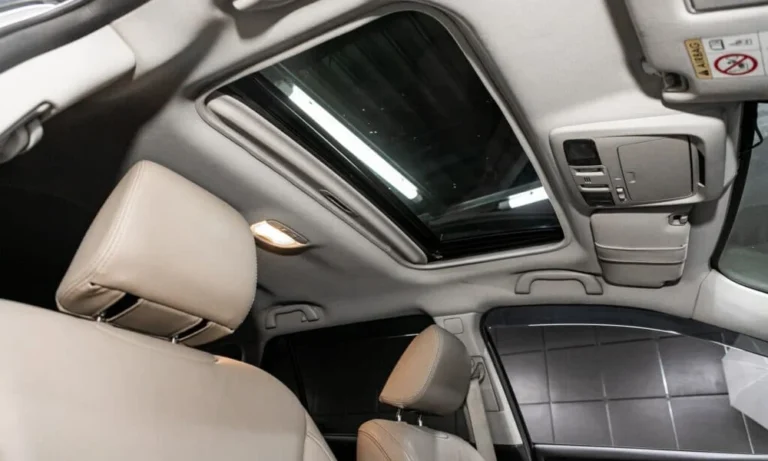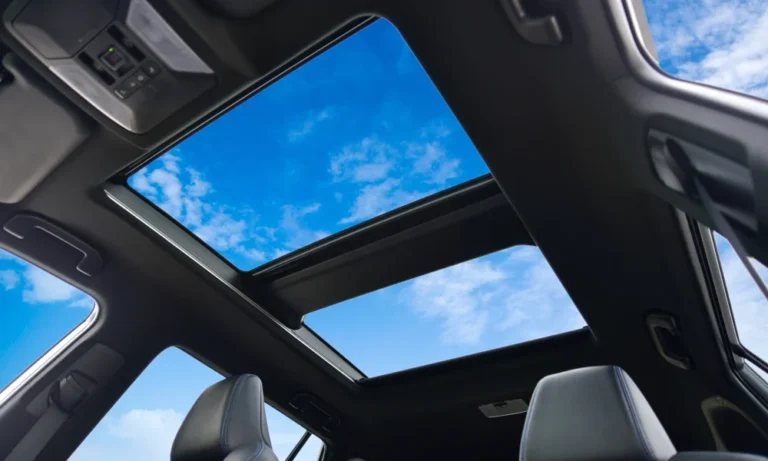How To Replace A Sunroof Motor
How to replace a sunroof motor becomes essential when your sunroof stops working smoothly or gets stuck. The motor is the key component that powers the sliding and tilting functions of the sunroof. When it begins to fail, you may notice slow movement, strange noises, or total failure to open or close.
Ignoring these indicators may result in internal damage, electrical problems, or water leaks. A prompt replacement of the sunroof motor can restore correct operation and stop additional issues. In some cases, you may be able to fix the sunroof motor by checking fuses or clearing debris, but full replacement is often the long-term solution.
Step-by-Step Guide | How to Replace a Sunroof Motor

The motor may be the problem if your sunroof isn’t opening or closing correctly. A faulty sunroof motor can cause grinding noises, jamming, or complete failure. Here’s a complete sunroof motor replacement guide that helps you safely swap out the old motor with a new one.
Step 1: Disconnect the Battery
Before doing any electrical work, disconnect the negative terminal of your car battery. This prevents any risk of short circuits or accidental sunroof movement during the repair.
Step 2: Remove the Interior Trim or Headliner
To access the sunroof motor, you’ll need to remove the trim or headliner panel. Carefully pry off any clips or screws holding it in place. Be gentle to avoid damaging the fabric or breaking the clips.
Step 3: Locate the Sunroof Motor
The sunroof motor is usually mounted near the front of the sunroof assembly, often between the driver and passenger seats on the ceiling. It may be hidden behind a plastic cover or within a cavity.
Step 4: Unbolt and Disconnect the Faulty Motor
Once located, unscrew the bolts holding the motor in place. Next, disconnect the electrical connector that is connected to it. You’ll be using the screws again for the replacement motor, so keep them safe. If there’s any sealant or insulation, remove it carefully.
Step 5: Install the New Sunroof Motor
Place the new sunroof motor in the same orientation. Reattach the wiring harness after bolting it into position. Make sure the motor’s gear is properly aligned with the sunroof mechanism. Poor alignment can cause the sunroof to jam or fail.
Step 6: Test the Sunroof Operation Before Reassembling
Before putting everything back, reconnect the battery and test the sunroof. To guarantee smooth movement, open and close it several times. Proceed to reattach the headliner or trim if everything functions well.
Tips for Proper Alignment and Wiring
- Mark the old motor’s position before removing it. This helps match the alignment during installation.
- Double-check the wiring harness for corrosion or damage. Replace if needed.
- Use dielectric grease on the connectors to prevent moisture buildup.
- If the sunroof won’t close completely after replacing the motor, perform a sunroof reset according to your car’s manual.
You can also read about How Much Does It Cost To Unclog Sunroof Drain.
How to Fix a 2013 Ford Explorer's Sunroof Motor
If your 2013 Ford Explorer sunroof is stuck or won’t operate, a failing motor could be the cause. This guide covers where the sunroof motor is located, how the disassembly differs from other models, and how to recalibrate the sunroof after installing a new motor.
The 2013 Ford Explorer’s sunroof motor location
The sunroof motor in a 2013 Ford Explorer is located behind the overhead console, near the front of the headliner between the driver and passenger seats. It’s housed within a plastic bracket that sits above the roof liner and just forward of the sunroof opening.
Tip: You must remove the overhead console and partially lower the headliner to access the motor.
Disassembly Steps – What’s Different for This Model?
Replacing the sunroof motor on a 2013 Ford Explorer involves more trim disassembly than many other vehicles. Here’s what you need to know:
Step-by-Step Breakdown
- Disconnect the Battery
As always, disconnect the negative terminal to cut power to the motor. - Remove the Overhead Console
The overhead console can be pryed off using a trim removal tool. Unplug any connectors (lights, sensors, etc.). - Lower the Headliner (Partially)
You don’t need to remove the entire headliner. Just lower the front section to create enough space. Carefully detach side pillar trims and sun visors to allow slack. - Locate and Remove the Old Motor
The sunroof motor is attached with three T25 Torx screws. Unbolt it and unplug the wiring connector. Note its position for correct alignment. - Install the New Motor
Fit the replacement sunroof motor into place, aligning the gear teeth with the sunroof mechanism. Reattach the harness and bolt it in place. - Reconnect Battery and Test
Temporarily connect the battery to test sunroof operation before reassembling.
Ford Explorer Sunroof Calibration Tips
After a sunroof motor replacement, the 2013 Explorer often needs calibration to restore auto open/close features.
Manual Calibration Steps:
- Turn the ignition ON (engine not required).
- Hold down the “CLOSE” button on the sunroof for ten seconds or more.
- The glass will begin to move — continue holding the button until the entire open-close cycle completes.
- Once the sunroof finishes moving, release the button.
You should read about What Is The Difference Between A Sunroof And A Moonroof.
How to Fix a Sunroof Motor Without Replacing It

Not every sunroof problem means you need a new motor. Many times, the issue is electrical or just needs some maintenance. Here’s how to troubleshoot and fix a sunroof motor without replacing it, along with tips for sunroof motor repair.
1. Check for Electrical Issues First
Before assuming the motor is bad, check the sunroof’s electrical system. Common issues like a blown fuse or bad relay can stop the sunroof from working — even if the motor is fine.
How to Check:
- Locate the sunroof fuse in your vehicle’s fuse box (check your owner’s manual for the exact location).
- Pull out the fuse and inspect it. Replace the metal strip if it is broken.
- If the sunroof relay is clicking but not turning on the motor, check it or replace it.
If power is restored after changing a fuse or relay, you’ve just completed a successful sunroof motor repair.
2. Reset the Sunroof Motor
Sometimes the sunroof motor just needs to be reset, especially after a battery change or if it gets out of sync.
Basic Reset Steps:
- Turn the ignition key to the “ON” position.
- Press and hold the sunroof close button for 10–15 seconds.
- Wait for the sunroof to cycle through a full open and close sequence.
- Release the button once it stops moving.
This reset trick often helps fix sunroof motor issues on Ford, BMW, Audi, and other vehicles.
3. Clean the Tracks and Check for Obstructions
If the motor is clicking but the sunroof won’t move, the problem could be a blocked or dirty track.
What to Do:
- Open the sunroof manually if possible.
- Use a vacuum and a clean cloth to remove dirt, debris, or hardened grease.
- Inspect for broken glass, leaves, or objects stuck in the rails.
Obstructions can stop the motor from moving the sunroof, making it seem like it’s broken when it’s not.
4. Lubricate the Sunroof Tracks
A dry or sticky sunroof track puts extra strain on the motor and can cause it to overheat or shut down temporarily.
Lubrication Tips:
- Use non-silicone, lithium-based grease made for sunroof or window tracks.
- Apply a small amount to the rails and manually move the sunroof back and forth to spread it.
- Wipe off any excess grease to avoid attracting dust.
Many people find that lubrication alone can fix sunroof motor performance without needing replacement.
When to Try Repair Over Replacement
You should attempt a sunroof motor repair if:
- The motor makes noise but doesn’t move the glass
- The sunroof stops midway or acts erratically
- Fuses and relays keep blowing (check for a short first)rks sometimes and fails randomly
How Much Does It Cost to Replace a Sunroof Motor?
The average cost for sunroof motor replacement in Austin typically ranges from $300 to $800, depending on your vehicle make and model, parts availability, and whether you hire a professional or choose the DIY route.
Average Cost of Parts
The sunroof motor itself usually costs between $150 to $400, depending on the brand and model of your car. For luxury or rare vehicles, this can jump to $500 or more. In Austin, local parts retailers or auto glass shops may offer better pricing or used parts for around $100 to $250, especially for common vehicles like Honda, Ford, or Toyota.
Labor Costs at Auto Shops vs. DIY Savings
Professional sunroof motor replacement labor in Austin usually costs $150 to $350, depending on the complexity of the job. Most auto shops charge between $90 to $150 per hour, and the process can take 1.5 to 3 hours.
If you’re mechanically inclined, doing the replacement yourself can save you up to 50% or more on labor. However, DIY work carries risks, such as misalignment, electrical faults, or roof damage if not handled carefully.
Pros of Professional Installation:
- Guaranteed results
- Warranty on labor
- Quicker and stress-free
Risks of DIY:
- No warranty on self-installed parts
- May take several hours without experience
- Can void coverage if not done correctly
Price Range for Common Makes and Models
Make & Model | Average Sunroof Motor Replacement Cost (Austin) |
Honda Civic / Accord | $300 – $500 |
Ford F-150 / Explorer | $350 – $600 |
Toyota Camry / Corolla | $300 – $550 |
BMW 3 Series / X5 | $500 – $800+ |
Chevrolet Silverado | $350 – $600 |
Hyundai Elantra / Sonata | $300 – $500 |
Keep in mind that panoramic sunroof systems can cost more due to extra labor and larger motors.
Warranty Coverage and Insurance Notes
Some extended warranties or manufacturer powertrain warranties may cover sunroof motor replacement, but typically only if it’s considered a manufacturing defect — not regular wear and tear.
Auto insurance often does not cover sunroof motor issues unless the damage was caused by an accident, falling debris, or vandalism. Comprehensive coverage might help in those specific cases.
Final Thoughts
While sunroof motor replacement can be a DIY task for those with the right tools and experience, there are certain situations where it’s best to call a professional. If you own a car with a complex sunroof system, such as a panoramic roof or a luxury brand, the replacement process can be more intricate and require specialized knowledge.
Additionally, if you’re concerned about water leaks or potential electrical damage, a professional like Texas Reliable Auto Glass can ensure the job is done right the first time, preventing further issues down the line. If you lack the necessary tools or experience, attempting the repair yourself can lead to costly mistakes. Contact us for any type of query or services related to repairing or sunroof motor replacement.
FAQs
How Do I Know If My Sunroof Motor Needs To Be Replaced?
If your sunroof isn’t opening or closing properly, is moving slowly, or has stopped working altogether, it could be a sign that the sunroof motor is failing. Other symptoms include unusual noises or a sunroof that gets stuck halfway.
Can I Replace The Sunroof Motor Myself?
While it’s possible to replace a sunroof motor yourself, the process can be complex. You’ll need specialized tools, experience, and the right replacement parts. If you’re not familiar with sunroof systems, it’s usually safer to call a professional like Texas Reliable Auto Glass to avoid damaging the sunroof or electrical components.
How Much Does It Cost To Replace A Sunroof Motor?
The cost of replacing a sunroof motor can range from $300 to $800 depending on your vehicle make and model. Labor costs in Austin typically range between $150 to $350, and parts themselves can cost between $150 to $400.
Can I Drive My Car With A Broken Sunroof Motor?
Driving with a broken sunroof motor is not ideal, especially if the sunroof is stuck open. It could expose your vehicle to water damage during rain or snow. It’s best to get it fixed as soon as possible by a professional auto glass repair service like Texas Reliable Auto Glass.
What Tools Are Needed To Replace A Sunroof Motor?
Replacing a sunroof motor typically requires tools such as a socket set, screwdrivers, trim removal tools, and possibly a multimeter to test electrical connections. Without the proper tools, it’s easy to damage surrounding components.

